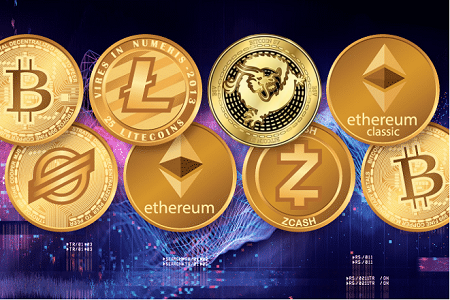Last updated on July 11th, 2023 at 11:37 pm
With the coming of cryptocurrencies and Non-Fungible Tokens, many have erroneously thought that only cryptos are digital currencies, but that is far from the truth. This article will go ahead to demystify digital currencies, cryptocurrencies, and much more.
As long as a currency can be accessed solely in a digital format, that currency is a digital currency. It is different from electronic versions of fiat currencies. Sending USD from one bank account to the other is not a digital currency transaction, but an electronic money transaction. Almost every country has an electronic format of their currency that allows people to send the country’s legal tender from one account to the other. Electronic money exists because it is impossible for the entire fiat currency like Pound Sterling in circulation to be in a hard copy or paper money format.
Types of digital currency
Digital currencies are divided into different aspects such as virtual currencies, cryptocurrencies, and Central Bank Digital Currency (CBDC).
Cryptocurrencies
Virtual currencies may have been around longer than cryptocurrencies, but the latter seems to have overshadowed the former in recent days. This type of digital currency stores and verifies the transactions on the blockchain, offering features like decentralization, immutability, transparency, security, and much more. Some cryptocurrencies are battling the blockchain trilemma. Ethereum, for instance, is secure and decentralized, but slow. This may change when the revised and better version of Ethereum, ETH 2.0, is released in 2022.
Different cryptocurrencies offer varying underlying features. Ethereum has a blockchain that permits developers to create decentralized apps and protocols. Vechain is injecting efficiency into supply chain services. Kine Protocol is improving the decentralized derivatives trading experience for traders all over the world. These innovations are usually powered by the native tokens of these ecosystems.
Virtual Currencies
Virtual currencies are currencies that are utilized solely in a platform. They can’t be traded or exchanged and possess no use case outside their ecosystem. An example is a currency seen in the gaming realm. In the particular game, these virtual currencies can be used to buy weapons for conquests, but they can’t be utilized anywhere else.
CBDC
The third type of digital currency that seems to be the rave of the moment is CBDC. Many countries, at the moment, are creating their Central Bank Digital Currency, which is backed by their governments. Some countries like China are clamping down on cryptos like Bitcoin while researching how to create the country’s digital currency.
CBDC and cryptocurrencies are similar because both are expected to reside on a blockchain, though at the moment, the concept of CBDC is theoretical. Though there may be a few similarities between CBDC and cryptocurrencies, they still have some differences. A major difference between CBDC and crypto is that the former is backed and issued by the government, while the latter is not.
One may wonder how CBDC is different from electronic money. In a typical electronic money transaction, transaction speed is slow, and the sender can file a complaint to recall the money that they had sent earlier. This is not the case with CBDC. Any fund that is sent, in this case, is quick, and it can’t be canceled, sharing some similarities with cryptocurrencies.
Digital currencies, especially cryptos and CBDC, have the advantage of rapid transaction speed and reduced bottlenecks. For instance, it is easy for someone in Tokyo to send Bitcoin to a person residing in Norway within a few minutes, and without having to worry about filling long forms or undergoing rigorous transaction processes.
If the sender in Tokyo had done that with the electronic version of a fiat currency, it may not take a long time. What is the level of transaction cost? Sending cross-border funds through the traditional banking system is not an affordable venture. The different middlemen involved in the transaction will take a cut of the funds sent as fees, but that can’t be said for digital currencies. Since it is free from intermediaries, the transaction cost is usually minute for digital currencies compared to electronic transfer.
Digital currencies are highly transparent, especially when cryptocurrencies are concerned. Cross-checking a transaction that has occurred on a blockchain is easier compared to one that happened through a traditional financial institution.
Method of operation
Cryptocurrencies are created in a blockchain platform, with data about their exchange and transaction stored in the public ledger. When crypto like BTC or Ether is transferred from one wallet to another, the transaction must be verified by miners and stored in a block. To do this, a gas fee is charged by the miners. Records of the transaction can be accessed by anyone, though the person behind the account may be anonymous to an extent.
For proof-of-stake platforms, the transactions are verified by validators, and the process of verification doesn’t consume large computing power.
Digital Currency Vs Cryptocurrency
Cryptocurrency is a type of digital currency, but it is different from other types of digital currencies in the following ways:
Element of centralization
Digital currencies like CBDC and virtual currencies have an element of centralization in their operation because there is a group that decides what happens in the ecosystem. In CBDC, the government regulates it and decides what occurs, while in virtual currency, the native platform is the decision-maker. As for cryptocurrencies, the opposite is the case because the community members create proposals and cast votes on them.
Level of transparency
Transparency is one reason that many opt for cryptocurrencies. Anyone can see the level of transactions that have been carried out by a wallet address. On the other hand, that can’t be said for other types of digital currencies. Though CBDC may not be in existence at the moment, many crypto enthusiasts do not believe that they would be as transparent as cryptocurrencies.
Volatility
Volatility is not much of a problem in the CBDC principle because it is backed by the central bank of a country. Central banks are known to create policies to influence the value of their currencies, and this may not be different for CBDCs. Stable coins are similar to CBDCs in this aspect because the former is usually pegged to fiat currencies. Popular examples are USDT, USDC, and BUSD.
Cryptocurrencies are a different ballgame. Since they are decentralized, the value is strongly affected by demand and supply, making it highly volatile. In 2021 alone, the crypto world has experienced the warm embrace of the bull market and the fierce waters of the bear market. The volatility to this extent may not be common in CBDCs in theory. This is because they derive their legitimacy from the issuing government. Countries with poor monetary and fiscal policies may be an exception to this theory.
Is digital currency traceable?
A key assumption of cryptocurrency is anonymity, which attracts a lot of users. Many want to carry out anonymous transactions. Its anonymity feature has made crypto a go-to currency for those that want anonymity like hackers. This is one reason some governments have enacted laws that are against cryptos.
Is crypto truly anonymous? The answer is yes and no. If an item is truly anonymous, it shouldn’t be as transparent as cryptocurrency, right?
Every transaction that occurs in a blockchain can be viewed by anyone, meaning that the transactions linked to a wallet address can be tracked.
Yes, it is anonymous because an address can receive or send cryptos without the identity of its owner being leaked. A crypto enthusiast can own multiple addresses without anyone knowing that they do, except in some situations.
When someone registers on an exchange and sends crypto from their private wallet address to the exchange address, their identity may easily be uncovered if a forensic blockchain audit is done on the transaction by an expert with the knowledge. This is because exchanges, especially the centralized ones, request their users to submit means of identification and details about themselves. If the crypto was sent from a private address to an exchange address, anyone can deduce that the private address may belong to the owner of the account on the exchange.
Another example is when a person or brand publishes their crypto address on a public platform. Anyone can see the balance of that address and easily trace the address that the crypto was sent to, in cases where it was moved.
Conclusion
- At the moment, CBDCs are theoretical in nature because no country has yet to release a working model of the CBDC. Countries like China are still researching the right way to create their CBDC to ensure that it mimics cryptocurrency in some aspects.
- Virtual currencies are restricted to only a platform and have no use case outside their native ecosystem.
- Cryptocurrencies are highly decentralized and offer incredible use cases to their community members.
If you would like to read more articles like this, follow DeFi Planet on Twitter and LinkedIn





















